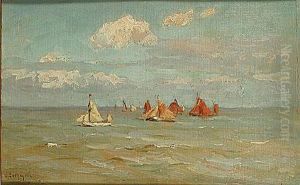Lemayeur Paintings
Adrien-Jean Le Mayeur de Merprès, commonly known as Le Mayeur, was a Belgian painter who is best known for his works that capture the culture and lifestyle of Bali, Indonesia. Born on February 9, 1880, in Brussels, Belgium, Le Mayeur hailed from an aristocratic family with a lineage of diplomats and artists. He developed an interest in art at an early age and pursued his passion for painting throughout his life.
Le Mayeur received his formal art education at the Académie Royale des Beaux-Arts in Brussels. After completing his studies, he traveled extensively through Africa and Europe, but it was his trip to Asia that profoundly influenced his artistic career. In 1932, Le Mayeur arrived in Bali, which at that time was a Dutch colony. Enchanted by the island's tropical beauty, vibrant culture, and the grace of its inhabitants, he decided to settle in the seaside village of Sanur.
In Bali, Le Mayeur was captivated by the local landscapes and the Balinese people, particularly the women, who became the central subjects of his paintings. His works from this period are characterized by bright, vivid colors and a strong sense of light, capturing the essence of the tropical environment and the leisurely pace of life on the island.
A pivotal moment in Le Mayeur's life was his meeting with Ni Wayan Polok Tjoeglik, a renowned Balinese Legong dancer, who became his muse and wife. Polok, also known as Ni Pollok, featured prominently in many of his paintings, often depicted amidst lush gardens or traditional Balinese settings. Their relationship was not only a romantic partnership but also an artistic collaboration that significantly impacted Le Mayeur's work.
Le Mayeur's paintings gained international recognition, and he held successful exhibitions in Singapore, the United States, and Belgium. His style, which combined elements of impressionism with the decorative quality of Balinese art, resonated with collectors and art enthusiasts around the world.
Towards the end of his life, Le Mayeur's health began to decline, and he struggled with deteriorating eyesight. Despite these challenges, he continued to paint until his death on May 31, 1950. Today, the home where Le Mayeur and Ni Pollok lived in Sanur has been preserved as the Le Mayeur Museum, showcasing his works and celebrating his contribution to the art world as well as his love for Bali and its culture.
